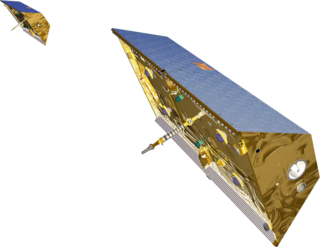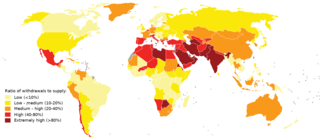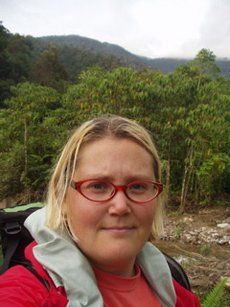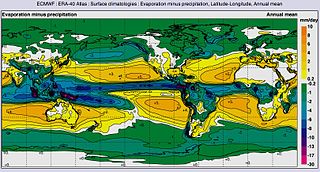Related Research Articles

The water cycle, also known as the hydrologic cycle or the hydrological cycle, is a biogeochemical cycle that describes the continuous movement of water on, above and below the surface of the Earth. The mass of water on Earth remains fairly constant over time but the partitioning of the water into the major reservoirs of ice, fresh water, saline water and atmospheric water is variable depending on a wide range of climatic variables. The water moves from one reservoir to another, such as from river to ocean, or from the ocean to the atmosphere, by the physical processes of evaporation, condensation, precipitation, infiltration, surface runoff, and subsurface flow. In doing so, the water goes through different forms: liquid, solid (ice) and vapor.

Groundwater is the water present beneath Earth's surface in rock and soil pore spaces and in the fractures of rock formations. About 30 percent of all readily available freshwater in the world is groundwater. A unit of rock or an unconsolidated deposit is called an aquifer when it can yield a usable quantity of water. The depth at which soil pore spaces or fractures and voids in rock become completely saturated with water is called the water table. Groundwater is recharged from the surface; it may discharge from the surface naturally at springs and seeps, and can form oases or wetlands. Groundwater is also often withdrawn for agricultural, municipal, and industrial use by constructing and operating extraction wells. The study of the distribution and movement of groundwater is hydrogeology, also called groundwater hydrology.

The Gravity Recovery and Climate Experiment (GRACE) was a joint mission of NASA and the German Aerospace Center (DLR). Twin satellites took detailed measurements of Earth's gravity field anomalies from its launch in March 2002 to the end of its science mission in October 2017. The GRACE Follow-On (GRACE-FO) is a continuation of the mission on near-identical hardware, launched in May 2018.

Groundwater recharge or deep drainage or deep percolation is a hydrologic process, where water moves downward from surface water to groundwater. Recharge is the primary method through which water enters an aquifer. This process usually occurs in the vadose zone below plant roots and, is often expressed as a flux to the water table surface. Groundwater recharge also encompasses water moving away from the water table farther into the saturated zone. Recharge occurs both naturally and through anthropogenic processes, where rainwater and or reclaimed water is routed to the subsurface.
Overdrafting is the process of extracting groundwater beyond the equilibrium yield of the aquifer. Groundwater is the fresh water that can be found underground; it is also one of the largest sources. Groundwater depletion can be comparable to "money in a bank", The primary cause of groundwater depletion is pumping or the excessive pulling up of groundwater from underground aquifers.

Water scarcity is the lack of fresh water resources to meet the standard water demand. There are two types of water scarcity: physical or economic water scarcity. Physical water scarcity is where there is not enough water to meet all demands, including that needed for ecosystems to function effectively. Arid areas for example Central and West Asia, and North Africa often suffer from physical water scarcity. On the other hand, economic water scarcity is caused by a lack of investment in infrastructure or technology to draw water from rivers, aquifers, or other water sources, or insufficient human capacity to satisfy the demand for water. Much of Sub-Saharan Africa has economic water scarcity.

Soil Moisture Active Passive (SMAP) is a NASA environmental monitoring satellite launched on 31 January 2015. It was one of the first Earth observation satellites developed by NASA in response to the National Research Council's Decadal Survey.
The University of California Center for Hydrologic Modeling (UCCHM) is a campus-wide hydrologic modeling research center, located at the University of California, Irvine. The models and modeling frameworks developed at the center address the urgent environmental and health issues related to water availability, such as how water availability will change in response to external factors like global climate change, how water availability will change with diminishing snow and ice, and how the frequency of hydrologic extremes will affect the state of California. The UCCHM team, made up of faculty, researchers and students, is working towards creating a state-of-the-art integrated model of California water resources that can influence and inform leaders of local, state and regional governments when making water management decisions.
The global freshwater model WaterGAP calculates flows and storages of water on all continents of the globe, taking into account the human influence on the natural freshwater system by water abstractions and dams. It supports understanding the freshwater situation across the world's river basins during the 20th and the 21st centuries, and is applied to assess water scarcity, droughts and floods and to quantify the impact of human actions on e.g. groundwater, wetlands, streamflow and sea-level rise. Modelling results of WaterGAP have contributed to international assessment of the global environmental situation including the UN World Water Development Reports, the Millennium Ecosystem Assessment, the UN Global Environmental Outlooks as well as to reports of the Intergovernmental Panel on Climate Change. WaterGAP contributes to the Intersectoral Impact Model Intercomparison Project ISIMIP, where consistent ensembles of model runs by a number of global hydrological models are generated to assess the impact of climate change and other anthropogenic stressors on freshwater resources world-wide.
Soroosh Sorooshian is an Iranian-born American civil engineer, and educator. He is a distinguished professor of civil and environmental engineering at the University of California, Irvine and currently serving as the Director of the Center for Hydrometeorology and Remote Sensing.

In summer 1965, the first close-up images from Mars showed a cratered desert with no signs of water. However, over the decades, as more parts of the planet were imaged with better cameras on more sophisticated satellites, Mars showed evidence of past river valleys, lakes and present ice in glaciers and in the ground. It was discovered that the climate of Mars displays huge changes over geologic time because its axis is not stabilized by a large moon, as Earth's is. Also, some researchers maintain that surface liquid water could have existed for periods of time due to geothermal effects, chemical composition or asteroid impacts. This article describes some of the places that could have held large lakes.
The Arabian Aquifer System is primarily located in Saudi Arabia but also in Jordan, Syria, Iraq, Kuwait, Bahrain, Qatar, United Arab Emirates, Oman, and Yemen.

Amy Townsend-Small is the director of the Environmental Studies Program as well as an associate professor in the Department of Geology and Geography at the University of Cincinnati.
Petra Döll is a German hydrologist whose work focuses on modeling global water resources. She is a professor of hydrology and researcher at the Institute of Physical Geography, Goethe University Frankfurt.
Efi Foufoula-Georgiou is a Distinguished Professor in the Civil and Environmental Engineering department at the University of California, Irvine. She is well known for her research on the applications of wavelet analysis in the fields of hydrology and geophysics and her many contributions to academic journals and national committees.
Bridget R. Scanlon is an Irish and American hydrogeologist known for her work on groundwater depletion and groundwater recharging, and of the effects of climate change and land usage patterns on groundwater. She is a senior research scientist in the Bureau of Economic Geology at the University of Texas at Austin, where she is head of the Sustainable Water Resources Program. Her research has included the use of GRACE satellite data to compare drought conditions in Texas and California.
Amir AghaKouchak is an Iranian American civil engineer, academic and researcher. He is a Professor of Civil Engineering, Environmental Engineering, and Earth System Science at University of California, Irvine.
Moustafa T. Chahine was an atmospheric scientist and an international leader in atmospheric remote sensing using satellite observations. He was the Science Team Leader for the Atmospheric Infrared Sounder on NASA's Earth Observing System Aqua satellite, and the Chairman of the Global Energy and Water Exchanges (GEWEX) Science Steering Group of the World Climate Research Program (WCRP).

The effects of climate change on the water cycle has important knock-on effects on the availability of freshwater resources, as well as other water reservoirs such as oceans, ice sheets, atmosphere and land surface. The water cycle is essential to life on earth and plays a large role in the global climate and the ocean circulation. The warming of the earth is expected to cause changes in the water cycle for various reasons. A warmer atmosphere can contain more water vapor which has effects on evaporation and rainfall. Oceans play a large role as well, since they absorb 93% of the increase in heat since 1971. This has effects on the water cycle and on human society, since the ocean warming directly leads to sea level rise.
Isabella Velicogna is a geoscientist known for her work using gravity measurements from space to study changes in the polar ice sheets and water storage on Earth.
References
- ↑ NASA.gov
- 1 2 Famiglietti, J. S. (2014). "The global groundwater crisis". Nature Climate Change. 4 (11): 945–948. Bibcode:2014NatCC...4..945F. doi:10.1038/nclimate2425.
- ↑ "UC Irvine – Faculty Profile System". .faculty.uci.edu. Retrieved 2015-10-14.
- ↑ "UC Irvine – Faculty Profile System". faculty.uci.edu. Retrieved 2015-10-14.
- ↑ "About". Jay Famiglietti. 2013-07-11. Retrieved 2015-10-14.
- ↑ Scott, A. O. (2012-05-03). "When There Really Is Not a Drop to Drink 'Last Call at the Oasis,' a Documentary About Water Supplies". New York Times. Retrieved 2015-10-12.
- ↑ "Depleting the water". www.cbsnews.com. Retrieved 2015-10-13.
- ↑ "Watch Clips and other Real Time with Bill Maher videos online on HBO.com". HBO. Retrieved 2015-10-13.
- 1 2 "UC Irvine – Faculty Profile System". faculty.uci.edu. Retrieved 2014-01-29.
- ↑ "Science – Earth Science: People: James S. Famiglietti". science.jpl.nasa.gov. Archived from the original on 2015-09-07. Retrieved 2015-10-14.
- ↑ Barringer, Felicity (2011-05-30). "Groundwater Depletion Is Detected by Grace Satellites". The New York Times. ISSN 0362-4331 . Retrieved 2015-10-14.
- 1 2 Rodell, Matthew; Velicogna, Isabella; Famiglietti, James S. (2009). "Satellite-based estimates of groundwater depletion in India". Nature. 460 (7258): 999–1002. Bibcode:2009Natur.460..999R. doi:10.1038/nature08238. PMID 19675570. S2CID 4428681.
- 1 2 Famiglietti, J. S.; Lo, M.; Ho, S. L.; Bethune, J.; Anderson, K. J.; Syed, T. H.; Swenson, S. C.; de Linage, C. R.; Rodell, M. (2011-02-01). "Satellites measure recent rates of groundwater depletion in California's Central Valley" (PDF). Geophysical Research Letters. 38 (3): L03403. Bibcode:2011GeoRL..38.3403F. doi: 10.1029/2010GL046442 . ISSN 1944-8007.
- ↑ Voss, Katalyn A.; Famiglietti, James S.; Lo, MinHui; de Linage, Caroline; Rodell, Matthew; Swenson, Sean C. (2013-02-01). "Groundwater depletion in the Middle East from GRACE with implications for transboundary water management in the Tigris-Euphrates-Western Iran region". Water Resources Research. 49 (2): 904–914. Bibcode:2013WRR....49..904V. doi:10.1002/wrcr.20078. ISSN 1944-7973. PMC 3644870 . PMID 23658469.
- ↑ Castle, Stephanie L.; Thomas, Brian F.; Reager, John T.; Rodell, Matthew; Swenson, Sean C.; Famiglietti, James S. (2014-08-28). "Groundwater depletion during drought threatens future water security of the Colorado River Basin". Geophysical Research Letters. 41 (16): 5904–5911. Bibcode:2014GeoRL..41.5904C. doi:10.1002/2014GL061055. ISSN 1944-8007. PMC 4373164 . PMID 25821273.
- ↑ Frankel, Todd C. (2015-06-16). "New NASA data show how the world is running out of water". The Washington Post. ISSN 0190-8286 . Retrieved 2015-10-14.
- 1 2 Richey, Alexandra S.; Thomas, Brian F.; Lo, Min-Hui; Reager, John T.; Famiglietti, James S.; Voss, Katalyn; Swenson, Sean; Rodell, Matthew (2015-07-01). "Quantifying renewable groundwater stress with GRACE". Water Resources Research. 51 (7): 5217–5238. Bibcode:2015WRR....51.5217R. doi:10.1002/2015WR017349. ISSN 1944-7973. PMC 4744761 . PMID 26900185.
- ↑ "Responding to the Challenge of Climate and Environmental Change: NASA's Plan for a Climate-Centric Architecture for Earth Observations and Applications from Space" (PDF). NASA. Archived from the original (PDF) on July 28, 2010. Retrieved October 13, 2015.
- ↑ "Famiglietti". Honors Program. Retrieved 2015-10-14.
- ↑ "Geological Society of America – Fellowship". www.geosociety.org. Retrieved 2015-10-14.
- ↑ "Home – Hydrogeology Division".
- ↑ "Water 50/50".
- ↑ "David Keith Todd Distinguished Lecture Series to honor Dr. Todd for his contributions to groundwater science and technology". Archived from the original on 2015-10-03. Retrieved 2015-10-14.
- ↑ Famiglietti, J. S., "The Global Groundwater Crisis", NatureClimate Change, 2014.
- ↑ Famiglietti, J. S., "Emerging trends in global freshwater availability", Nature, 2018.
- ↑ "California's water house of cards". Los Angeles Times . Retrieved 2015-10-14.
- ↑ "How much water does California have left?". Los Angeles Times . Retrieved 2015-10-14.
- ↑ "California has about one year of water stored. Will you ration now?". Los Angeles Times . Retrieved 2015-10-14.
- ↑ "Food industry needs to step up on responsible groundwater use". San Francisco Chronicle. Retrieved 2015-10-14.
- ↑ "Real Time with Bill Maher, 'When in Drought' with Prof. Jay Famiglietti". HBO.
- ↑ "CBS This Morning, 'California governor defends sparing farmers from drought rules'". CBS.
- ↑ "Arnold @Schwarzenegger on Twitter". Twitter.com.
- ↑ "Tavis Smiley". PBS.
- ↑ "Jay Famiglietti – National Geographic Society Newsroom".
- ↑ "Jay Famiglietti | HuffPost". HuffPost .